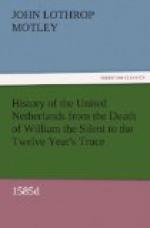The cathedral had been thoroughly fumigated with frankincense, and besprinkled with holy water, to purify the sacred precincts from their recent pollution by the reformed rites; and the Protestant pulpits which had been placed there, had been soundly beaten with rods, and then burned to ashes. The procession entered within its walls, where a magnificent Te Deum was performed, and then, after much cannon-firing, bell-ringing, torch-light exhibition, and other pyrotechnics, the Prince made his way at last to the palace provided for him. The glittering display, by which the royalists celebrated their triumph, lasted three days’ long, the city being thronged from all the country round with eager and frivolous spectators, who were never wearied with examining the wonders of the bridge and the forts, and with gazing at the tragic memorials which still remained of the fight on the Kowenstyn.
During this interval, the Spanish and Italian soldiery, not willing to be outdone in demonstrations of respect to their chief, nor defrauded of their rightful claim to a holiday amused themselves with preparing a demonstration of a novel character. The bridge, which, as it was well known, was to be destroyed within a very few days, was adorned with triumphal arches, and decked with trees and flowering plants; its roadway was strewed with branches; and the palisades, parapets, and forts, were garnished with wreaths, emblems, and poetical inscriptions in honour of the Prince. The soldiers themselves, attired in verdurous garments of foliage and flower-work, their swart faces adorned with roses and lilies, paraded the bridge and the dyke in fantastic procession with clash of cymbal and flourish of trumpet, dancing, singing, and discharging their carbines, in all the delirium of triumph. Nor was a suitable termination to the festival wanting, for Alexander, pleased with the genial character of these demonstrations, repaired himself to the bridge, where he was received with shouts of rapture by his army, thus whimsically converted into a horde of fauns and satyrs. Afterwards, a magnificent banquet was served to the soldiers upon the bridge. The whole extent of its surface, from the Flemish to the Brabant shore—the scene so lately of deadly combat, and of the midnight havoc caused by infernal enginery—was changed, as if by the stroke of a wand, into a picture of sylvan and Arcadian merry-making, and spread with tables laden with delicate viands. Here sat that host of war—bronzed figures, banqueting at their ease, their heads crowned with flowers, while the highest magnates of the army, humouring them in their masquerade, served them with dainties, and filled their goblets with wine.




